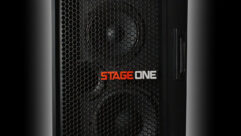

Wireless AV: No Strings Attached
PRO AV’s resident streaming media experts has seen enough wireless versions of the technology to know moving AV over the air is getting close to prime time. How will AV pros use it?
Pete Putman
Credit: Chris Whitney
The first third of the year is always full of trade-show activity, from the Consumer Electronics Show in January to the National Association of Broadcaster’s show in April. I spend this time of year studying the trends that will affect the pro AV industry for the remainder of the year and beyond. And this year, I’ve been searching out the latest and greatest in display technology and investigating the trend toward Internet delivery of content to televisions and mobile devices, including umpteen-million tablet computers and smart phones.
I’ve also done some digging into the emerging world of wireless audio and video connectivity. I don’t mean stuff like Bluetooth (not enough bandwidth) or 802.11n (inconsistent in its delivery capabilities because of a shared bandwidth structure). I wanted to learn more about full-bandwidth audio/video streaming from Blu-ray players, media servers, video cameras, and computers to video monitors, projectors, and televisions. In short, how can we as AV professionals ditch the HDMI or DVI cables and port those beautiful 1080p/60 images through the ether to the big screen?
The appeal of going wireless is easy to understand from a consumer’s perspective. You can place your TV, AV receiver, Blu-ray player, set-top box, and other gadgets anywhere you want in a room and stream content to your TV, eliminating a bunch of cables along the way. In some cases, you might even be able to stream content beyond the room to a mobile device, such as a tablet.
Does this sort of thing have any application in the pro AV space? Yes, in certain situations, although it’s still a better idea to go with a wired infrastructure for most installed AV gear. Having wireless makes it easier for a presenter, for example, to visit a presentation space and quickly connect to the system without having to use pop-up or underdesk interface boxes, or having to (gasp!) string cables to a rack-mounted patch panel.
Believe me, wireless connectivity is very much alive and kicking. Everybody wants it. The Federal Communications Commission wants to chop off 120MHz of the current UHF TV spectrum to enable more high-speed 802.11 connectivity around the country. But no one wants it more than electronics manufacturers.
At present, there aren’t a lot of solutions available. Ultra-wideband (UWB) is a strong contender and uses enormously wide channels to distribute high-bandwidth video, audio, and control signals in the 3GHz to 10GHz spectrum. UWB uses very low power and is basically restricted to a single room—as you move farther away from the transmitter, the carrier-to-noise level drops and so does the available bandwidth.
Another solution being floated out there comes from the Wireless High Definition Interface (WHDI) group, fronted by Israeli semiconductor company Amimon. WHDI uses a somewhat more conventional approach to transmit audio and video in narrower channels (20MHz and 40MHz) in a portion of that same RF spectrum as UWB.
Both systems accommodate the HDMI interface. They can also handle DisplayPort, along with wireless USB (WUSB) 3.0 and other control signals.
At CES, Samsung showed a fascinating application of UWB: a wireless docking station for laptop computers. As the WUSB-equipped laptop came within 3 feet of the docking station, the monitor, keyboard, and mouse powered up, as well as a USB hub in the base of the monitor. All content on the laptop screen was automatically mirrored or moved to the docking-station monitor. All that was left to do was plug AC power into the laptop (sorry, no wireless AC yet). When the session was done, the user simply picked up the laptop and moved it away. The docking station waited a short interval to be sure that the user had truly left (and hadn’t just dropped the signal), and then powered everything down automatically.
In the WHDI suite at the Hilton, I saw a variety of demonstrations, including Blu-ray discs streaming from conventional players to specially equipped LG Electronics and Hisense LCD TVs, wireless video streaming from a JVC Everio 1080p camcorder to another LCD TV, and 1920×1200 graphics and games streaming from an Nvidia video card to a high-resolution workstation monitor. (It took five antennas on the graphics card to make it happen.)
WHDI even had an adapter for smart phones to stream video and share photos using a specially designed WHDI “clamshell” for the Apple iPhone. In short, anything you wanted to move at a high bit rate could be moved wirelessly throughout the hotel suite to multiple displays, with no dropouts and very low latency.
A third solution, WirelessHD, is based on 60-GHz technology from Sibeam, and had a more subdued presence at CES. The company did, however, lay out a road map for being able to transmit 4K resolution content and 3D.
More recently, I just got back from Samsung’s spring line show in New York and it was all about connected media devices in every possible iteration, including Blu-ray players streaming video to plasma and LCD TVs using the Wireless HD protocol. You name it. There was wireless streaming from cameras and camcorders to TVs, Bluetooth-enabled active-shutter 3D glasses—Samsung had just about every gadget in that room connected sans wires. The coolest demo involved an LCD TV playing an HD program and simultaneously streaming it to three separate devices—a smart phone, a Samsung Galaxy tablet, and a special TV remote control with a built-in 4-inch LCD monitor. (I dubbed this the “I have to go to the bathroom but don’t want to miss the end of the game” remote.)
Wireless AV connectivity is going to be a big deal in the pro AV space. So much so that I’ll be teaching a class about it at InfoComm 2011 (“AV Signals Gone Wireless,” June 15, 8 a.m. to 10 a.m., at the convention center in Orlando, Fla.). I’m working on a few live-streaming demos using UWB and WHDI technology—nothing like “show-and-tell” to make a point. See you then!










